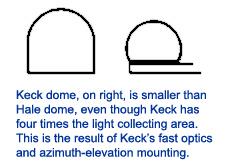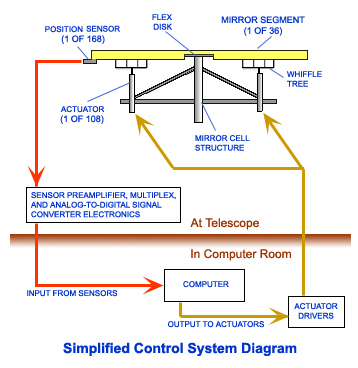Keck Telescope SCIENCE KIT Fact Sheet
Part 1. Highlights of The Keck TelescopesThe Largest Telescope in the WorldIt took almost 280 years from the time Galileo first examined the heavens with his small telescope in 1609, until an astronomical observatory was built on a mountain top: in 1888, the largest telescope in the world was a refractor featuring a 36-inch diameter objective lens, on Mount Hamilton in northern California. Owned and operated by the University of California (UC), the Lick Observatory made major discoveries about the universe in which we live. Later, the Carnegie Institution, together with the California Institute of Technology (Caltech), built instruments on Mount Wilson, and then on Mount Palomar, each of which became the world's largest in turn.
Throughout history, new technologies have been required to sustain the growth of telescope aperture (the most significant measure of light-gathering ability). Lick's 36-inch lens was about the largest, heaviest solid glass body that could be supported by its edge in a telescope. Telescopes much larger than that would have to use curved mirrors instead of lenses. Mirrors can be supported from behind, and they do not absorb any wavelengths of light, or cause chromatic errors, the way lenses do. Thus mirror technology replaced that of lenses in telescopes larger than about a meter in aperture. But this mirror technology ran to its limits, too. The 5-meter diameter mirror of the Hale telescope on Mount Palomar uses about the largest single piece of glass possible for a good mirror. Anything larger will deform too much under its own weight to be of use. Large monolithic glass mirrors take a long time to adjust to the night air's temperature, affecting their ability to focus, because of thermal contraction or expansion. They also require massive, complex mechanical support systems. For aperture to grow larger, a whole new technology was required once again — indeed a whole new paradigm.
Each of Keck's 36 mirror segments (plus spares) was cast in a relatively easy process, ground to its proper shape in a special process under tension, and then finished using an ion-polishing process. Keck's active optics would not, of course, be possible without the computer technology of today. The computer and its software are integral to the Keck Telescope's mirror. Telescope Mountings and Domes - More Hurdles ClearedThe telescope mounting also presented a major barrier to making telescopes larger than about 5 meters in aperture. The Hale Telescope's mount is extremely massive and complicated, in part because one of its axes is aligned with earth's axis (it is an equatorial mount). The Hale telescope's mount is perhaps the most robust equatorial mounting structure physically possible to engineer. It would clearly be a very difficult and prohibitively expensive undertaking to attempt to make a larger one. But today's computer technology also permits use of a simple, lightweight mounting structure which moves the telescope at right angles to the earth's surface (an altitude-azimuth mount, also called azimuth-elevation), doing away with the structural nightmare of a large equatorial system with its asymmetric loads. Instead of relying on the mechanical mounting to track the sky as the earth turns, computers calculate the exact increments to move the telescope in altitude and azimuth, and to rotate the telescope's instruments' fields of view. This fact, combined with the "fast" (f 1.7) optical design, which employs a relatively short telescope structure, also permits a relatively small dome to enclose the telescope. As a result, the dome for the 10-m aperture Keck Telescope is smaller than the dome which houses the 5m Hale telescope on Mount Palomar!
But today's computer technology also permits use of a simple, lightweight mounting structure which moves the telescope at right angles to the earth's surface (an altitude-azimuth mount, also called azimuth-elevation), doing away with the structural nightmare of a large equatorial system with its asymmetric loads. Instead of relying on the mechanical mounting to track the sky as the earth turns, computers calculate the exact increments to move the telescope in altitude and azimuth, and to rotate the telescope's instruments' fields of view. This fact, combined with the "fast" (f 1.7) optical design, which employs a relatively short telescope structure, also permits a relatively small dome to enclose the telescope. As a result, the dome for the 10-m aperture Keck Telescope is smaller than the dome which houses the 5m Hale telescope on Mount Palomar!
A Fine LocationAt the summit of Mauna Kea, the clear air is thin. The sky is dark, and well removed from city lights. Its height is above most of the water in Earth's atmosphere, so observations can be made in the infrared part of the spectrum which are impossible at down lower levels in earth's moist atmosphere. And the Keck Telescope is diffraction limited at infrared wavelengths.
Adding to the resolving power of the Keck Telescopes is a technique called Adaptive Optics, which serves to "untwinkle" the stars. This technique uses a small, computer-deformable mirror in the telescope's final light path, just before it enters the cameras or other instruments. Based on electronic inputs from a bright "guide star" near the target being observed in the sky that reveal the realtime deformations caused by turbulence in Earth's atmosphere, light fed to the instruments has had the atmosphere-caused scintillation reduced or removed. The Adaptive Optics technique is almost as good as putting the telescope in space above the atmosphere. A second Keck Telescope was being completed as your SCI KIT first went into production. Keck II is now in operation. Situated within the same observatory facility as the original Keck I Telescope, but in a separate dome, Keck II is virtually identical to its twin. The observatory is designed to permit interferometric observations using both telescopes, a technical feat which will achieve the resolving power of a telescope equal in aperture to the distance spanned by the two Keck Telescopes, which is 85 meters.
The Keck Telescopes are owned and operated by the California Association for Research in Astronomy, which is an association of the California Institute of Technology and the University of California. The telescopes are named in honor of William M. Keck. Gifts from the W. M. Keck Foundation made the telescopes possible. Your Keck Telescope SCI KIT could not have been produced without the kind permission and generous technical assistance of the Keck Observatory and the California Association for Research in Astronomy. Copyright © 1995-2007 SCI Space Craft International, Pasadena, CA U.S.A. Comparisons with the Hale 200-inch telescope here are of course not meant to belittle the Hale, which is indeed still very much a first-class research tool today. An excellent description of the Hale telescope and its history can be found in The Perfect Machine; Building the Palomar Telescope by Ronald Florence, Harper Perennial 1994. This book also provides an excellent background for appreciating the new paradigm represented by the Keck Telescopes and their contemporaries.
To keep up with discoveries made through use of the Keck Telescopes, refer to publications such as Science News, Sky & Telescope, and Astronomy, which frequently publish articles and images covering discoveries made using the Keck Telescope.
Go on to Part 2. Keck Telescope Light Path| SCI HOME PAGE | CATALOG | HOW TO ORDER | GREAT SPACE LINKS |
|
 The Keck Telescope's revolutionary design, a project managed by
The Keck Telescope's revolutionary design, a project managed by